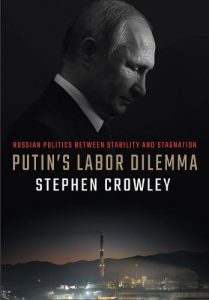Putin’s Labor Dilemma: Russian Politics Between Stability and Stagnation
 Putin’s Labor Dilemma: Russian Politics Between Stability and Stagnation by Stephen Crowley (Ithaca: Cornell University Press, 2021)
Putin’s Labor Dilemma: Russian Politics Between Stability and Stagnation by Stephen Crowley (Ithaca: Cornell University Press, 2021)
In Putin’s Labor Dilemma, Stephen Crowley asks a simple question whose answer is anything but: how can Russian leaders chart a positive economic future and avoid social unrest? While the cover of this monograph features the image of Russian President Vladimir Putin, a set of matryoshka (nesting) dolls would be just as fitting because any response to the question above invariably raises additional issues, each one bigger and more complex than the previous.
The Dilemma that Crowley refers to are the choices Russian policymakers have at their disposal. Reforming the labor market and industrial base is necessary in order to modernize the economy, which would require drastic changes on the part of Russian workers who have already endured significant hardships since the collapse of the Soviet Union. The alternative is to keep Soviet-era industries chugging along on life support, an option that guarantees low productivity, economic stagnation, and declining living standards. The rub is that either choice could potentially lead to the social unrest that the Kremlin fears. As Crowley explains, “by preventing mass layoffs, the government can maintain social stability, but only at the cost of economic growth, the absence of which is itself a potential threat to social stability.” (205) It’s an impossible situation.
Since the Russian invasion of Ukraine in February 2022 Vladimir Putin has been the subject of intense media scrutiny. The title of this monograph suggests more of the same, but that is hardly the case. Crowley, a political scientist who specializes in Russia and Eastern Europe, synthesizes extensive scholarship and contemporary literature, much of it Russian-language. His focus is on political economy, labor markets and labor relations, and economic geography. This latter subject is of particular importance since Russia’s population is scattered across hundreds of communities that span an immense geography and harsh climates.
One of the primary issues that Russian leaders must grapple with is monotowns: the several hundred communities constructed around a single industry such as steel, mining, or machine building during the Soviet period. This subject is so controversial, Crowley tells us, that authorities disagree on which communities qualify as monotowns. State subsidies have kept many of them afloat since the fall of the Soviet Union. Putin considers monotown residents a key constituency. For example, in 2009 he humiliated on national television an oligarch who had laid-off one-fifth of the workers in the monotown Pikalyovo (who responded by causing a massive traffic jam and appealing to Putin for help). Putin arrived, dressed down the oligarch, and got reassurances that the factories would not be idle for long. This was pure theater; a solution favorable to the oligarch had been reached the day before Putin’s arrival.
That workers in Pikalyovo responded to layoffs by causing a traffic jam and appealing to Putin reflects the problematic nature of labor relations in Russia. In most instances, Russian unions resemble their Soviet era predecessors, which did more to preempt labor-management conflict than they did to advance workers’ interests against managers and central planners. As Crowley observes, the consequences of weak unions are widespread: “the inability of unions to influence wages has directly shaped Russia’s extreme wage flexibility, its low wages and low labor productivity, and the failure of unions to reverse Russia’s huge growth in inequality.” (107) Since workers have few effective institutional mechanisms to address their problems, protests often erupt spontaneously and “as a result the Russian state is left with deep concerns about social stability.” (125) This is emblematic of a larger, more widespread legacy from the Soviet Union. On the one hand, populations in Russia and other former Soviet satellites (such as Hungary or Poland) have a “leftist bias” with regard to welfare and markets. On the other hand, there is a deficit of civil society organizations that can advance left policies, especially bona fide unions and political parties.
For a monograph about labor issues, Putin’s Labor Dilemma does not feature workers’ voices as much as one might expect. Still, Crowley is remarkably sympathetic to Russian workers with regard to the question of monotowns and workers’ mobility. Critics of monotowns, including reformers in Russia as well as the World Bank, recommend increasing workers’ mobility as a basic step towards economic liberalization. Crowley, however, recognizes that the familial and community connections monotown residents have developed over decades are “crucial for survival.” (92)
Crowley deserves recognition for writing about a complicated subject with clarity and compassion. Specialists and laypeople alike will learn something new from reading his work. It’s worth noting that Putin’s Labor Dilemma was published in July 2021, less than a year before Russia invaded Ukraine. Since then, its economy has been slapped with international sanctions as have government officials and oligarchs. Moreover, multinational corporations have fled the country and the European Union has banned the importation of Russian oil. It’s hard to imagine that conditions in monotowns are satisfactory to their populations unless, that is, they are flush with war production. Perhaps a handful of them are reaping the benefits of the conflict, but it’s unlikely that all of them are. In short, Putin’s gamble in Ukraine has most likely exacerbated the problems that Crowley details, but how they play out have yet to be determined.
Reviewed by John Lepley, a labor educator in Pittsburgh, Pennsylvania who serves on the Executive Board of United Steelworkers Local 3657. He attended Indiana University of Pennsylvania and Indiana State University.
